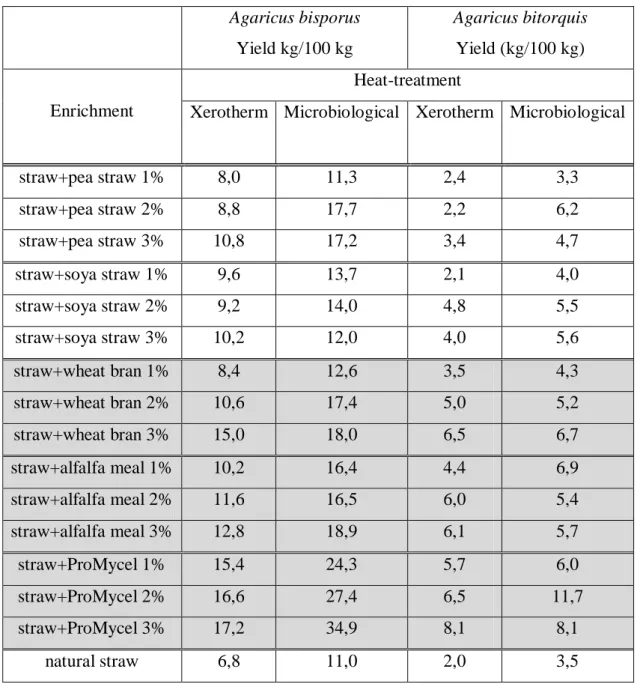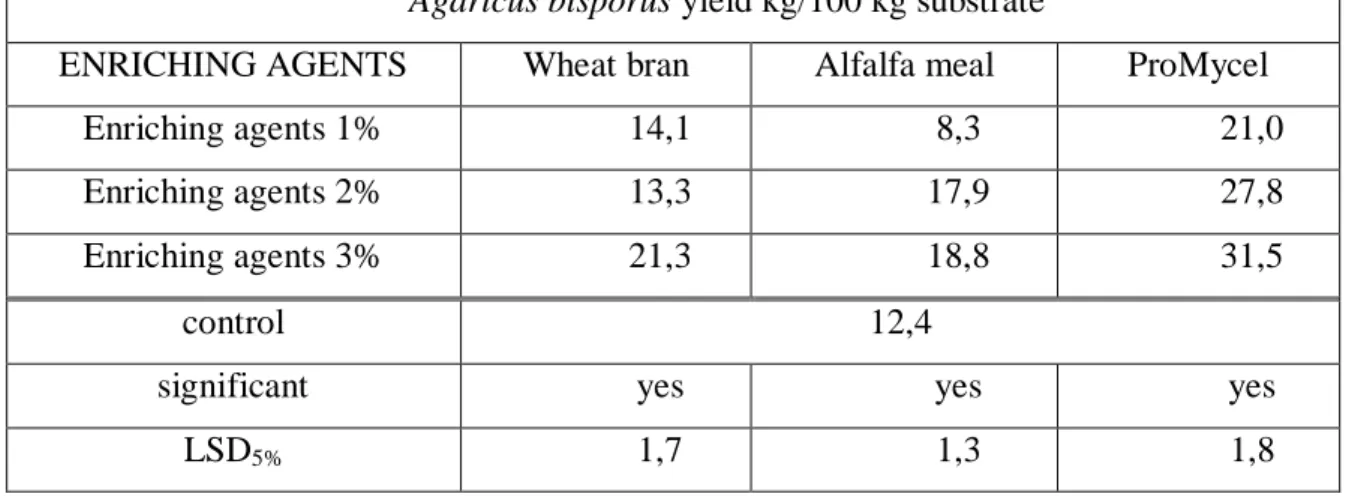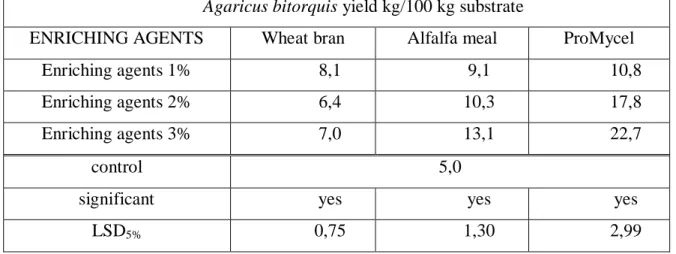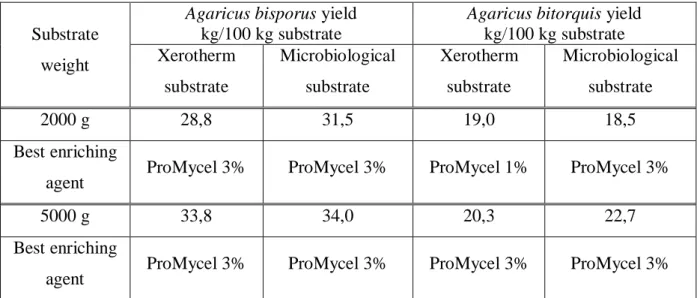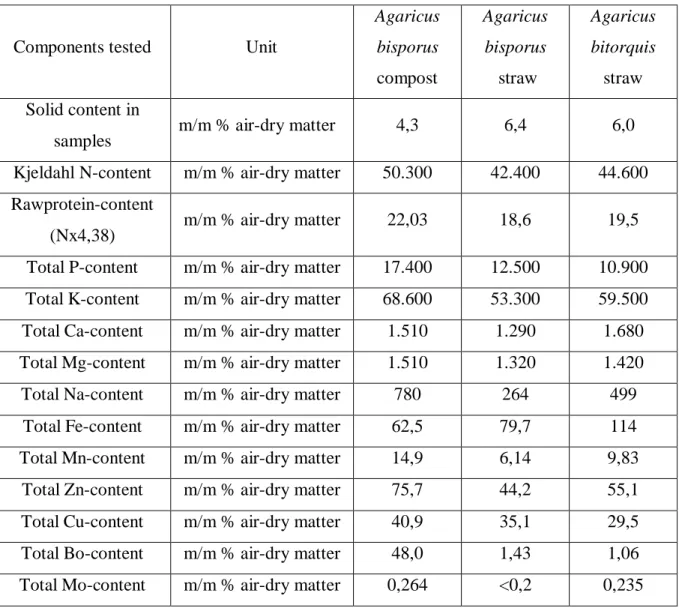CORVINUS UNIVERSITY OF BUDAPEST
YIELD INCREASE OF AGARICUS SPECIES ON STRAW SUBSTRATE
THESIS OF PhD DISSERTATION
by Krisztina Sándorné Ferenc
Supervisor:
Dr. habil. Júlia Gy
ırfi
Written at the Department of Vegetable and Mushroom Growing Corvinus University of Budapest
Budapest 2010
PhD School
Name: Doctoral School of Horticultural Sciences
Field: Crop Sciences and Horticulture
Head of Ph.D. School: Prof. Dr. Magdolna Tóth
Doctor of the Hungarian Academy of Sciences Head of Department of Fruit Sciences
CORVINUS UNIVERSITY OF BUDAPEST, Faculty of Horticultural Sciences
Supervisor: Prof. Dr. Júlia Gy
ırfi A ssociate professor , PhD
Department of Vegetable and Mushroom Growing CORVINUS UNIVERSITY OF BUDAPEST, Faculty of Horticultural Sciences
The applicant met the requirement of the PhD regulations of the Corvinus University of Budapest and the thesis is accepted for the defence process.
... ...
Head of Ph.D. School Supervisor
1. Research Background and Objectives
Considering the nearly 500 year old history of mushroom cultivation in Europe development has sped up enormously in the past 100 years. It was, however, a thorny path from the early cultivation methods based on empirical knowledge and associated with great risks and low yields to the modern, well elaborated, computer steered methods guaranteeing high yields. Thus, intensive mushroom production needs special knowledge, practice and equipment.
Using up-to-date technologies 35-45 kg mushroom/ 100 kg compost can be harvested.
In Hungary 20-35 kg / 100 kg compost yield can be expected. In the USA 30,1 kg / 100 m2 wascalculated for 2008/2009 on the average.
The modern composting technologies for Agaricus bisporus are universally known but due to variations in production conditions yields can vary widely.
In order to eliminate air pollution compost producers have recently invested in extra equipments hereby increasing their production costs. The Agaricus bisporus substrates of today is a compost made of mixture of straw, horse dung, poultry dung, gypsum and water.
Composting conditions need modernization to comply with the severe regulations. Dung composting involves the release of highly irritative, stinking ammonia and other gases in considerable quantity. When composting outdoors the foul smell is carried away km wide by the winds, polluting and making intolerable the surrounding environment. The foul smell, the probability of surface and ground water pollution, the problem of spent compost deposit aroused the attention of environment sensitive public who put pressure on the branch.
Technologies polluting air are also prohibited by authorities. Technical development is absolutely necessary. Today gases in composting farms are neutralised in half or completely closed environment which contributes to the costs of existing or planned production farms. A solution to get rid of foul smell is offered by the production of substrates which do not release such gases.
In Hungary Agaricus species were first produced on straw substrate in the Vegetable Crops Research Institute, in Kecskemét, followed by trials and observation for several years to find suitable methods. It was established that that the species Agaricus bisporus (J.E.
Lange) Imbach and Agaricus bitorquis (Quél) Sacc. can be cultivated successfully on heat- treated straw. Later, it is also cleared that there is no perceptible difference in taste and inner values between mushrooms cultivated on straw and those on compost.
Despite the fact that straw proved to be suitable substrate for Agaricus species, it has a drawback: low yield. On straw substrate Agaricus species seem to be unable to yield more than 15%.Growers would need twice as much to make straw competitive. If 30% could be achieved growers would switch over to straw. It follows that possibilities should be studied whether economically acceptable yields could be obtained on straw.
Experience showed that increasing the N-content of the substrate would be a key question. The N-content of the traditional dung compost is 2,0- 2,3 % in solids at spawning and about 0,5% in straw. It can be presumed that increasing the N-content of the straw may increase yield.
What advantages does the straw substrate show? First, no foul gases would be produced during composting. Further economical advantages the short - 1-2 days – substrate preparation time in contrast to the 14-16 days of traditional composting. The xerotherm heat- treatment method needs no costly equipment. Substrate production would be considerably cheaper. Straw substrate produced by microbiological heat-treatment is ready in 10-11 days from the mixture of basic materials to spawning.
The Hungarian research results were published and gave me opportunity to carry on research in this theme. My first investigations included means to find supplement to increase the N-content of straw. Compost farms have always used enrichments of organic or inorganic origin available in trade. The composition of some of them is known but mostly only the main components are given. In my trials I used organic enrichment agents available in trade (ProMycel) but also some agricultural wastes of high N-content (pea straw, soya straw, wheat bran, alfalfa meal) to improve the N-content of straw substrate.
My aim was to observe the productivity of Agaricus bisporus and Agaricus bitorquis species without composting on straw substrate of higher N-content produced by xerotherm or microbiological heat-treatment methods.
2. Material and methods
The trial series were carried on in the mushroom laboratory, climatized house and a cellar of ZKI Kecskemét. Trials were set up in 500, 2000 and 5000 g lots in random arrangement and replications. Preliminary trials (500 g) were interwoven by mycelia in the laboratory and cultivated in the cellar. The 2000 g and 5000 g lots were kept in the climatized growing house and then cultivated in the cellar.
Substrates
Substrate produced by xerotherm heat-treatment
In the preliminary trial one year old, 3-5 cm long chopped, baled wheat straw was used. The straw was completely healthy, free of contamination, air dry, that is, of about 12-14
% humidity. It was treated at 100ºC temperature with steam for 60 minutes in an autoclave.
When the autoclave cooled down, the straw was taken out, put into a tub and soaked in pure tap water. It stayed there overnight and the following day the superfluous water was removed by centrifugation. Straw of about 70 % humidity was obtained.
In the larger lots straw was treated by the xerotherm method in a heat-treatment equipment in Borota, an oyster mushroom substrate production farm. The machine filled the straw into perforated plastic bags. Further operations (weighing, spawning, enrichment) were performed in the mushroom laboratory on the day of the heat-treatment.
Substrate produced by microbiological heat-treatment
The process requires special equipments “home” methods cannot guarantee the proper quality. The basic material of the so-called microbiological process was prepared in an oyster mushroom substrate farm, Pilze-Nagy Kft. in Kecskemét.
The substrate also consisted of one year old wheat straw prepared outdoors on a concentrate surface for 6 days, that is, it was soaked in pure water and turned round daily. The straw of 70-76 % humidity was placed in the heat chamber and warmed up to 65ºC by steam.
It was kept at this temperature for 18 hours by dosing fresh air. After pasteurization the straw was cooled down quickly to 48-50ºC (the conditioning temperature) and kept there for 40-48 hours. Then it was cooled to the spawning temperature. After removing the straw from the heat chamber, it was ready for use (weighing, spawning, enrichment) performed on the same day.
Enrichment agents
In the preliminary trial 5 agricultural products and by-products, respectively, were used: chopped pea straw, soya stalk straw, wheat bran, alfalfa meal used for fodder and ProMycel (soya derivate) available in trade. Based on the results of the preliminary trial the 3 best agents were chosen for the further trials.
In our trials the enrichment agents were prepared by xerotherm heat-treatment.
Spawn
Grain spawn prepared of wheat grains was used: the strain Kbt of Agaricus bitorquis and strain T345 of Agaricus bisporus obtained from pure cultures of the laboratory.
Methods
The same method was followed both in the xerotherm and microbiological treatments.
Under pure laboratory conditions 500 g, 2000 g and 5000 g substrates, respectively, were weighed into a bowl and mixed with 1, 2, 3 weight % of enriching agents and 5 weight % of spawn.
The 500 g lots were placed in the mushroom laboratory at 24-25 ºC air temperature for Agaricus bisporus, at 26-28 ºC for Agaricus bitorquis, at 80-90% rel. air humidity. The lots of 2000 g and 5000 g were placed in the climatized growing house. Spawning growth occurred at 22-24 ºC in Agaricus bisporus, at 26-28 ºC in Agaricus bitorquis, at 80-90% rel. air humidity. Both trials had two replications.
A 5 figure code was used for marking. The first figure is for the mode of the heat- treatment, the second one for enrichment, the third for concentration, the forth for species and the fifth for replication. Heat-treated straw without enrichment served for control.
The rate of mycelium growth was checked daily.
The interwoven substrate was cased 4 cm thick with the traditional casing soil containing 90% peat and 10% beet potash of the sugar factory with pH values between 7,3- 7,5.
After casing 3g/m2 Sporgon 50 WP against fungi (Verticillium fungicola var.
fungicola, Mycogone perniciosa) and 4g/m2 Dimilin WP against larvae of mushroom mosquitoes (Lycoriella sp.) and flies (Heteropeza pygmaea and Mycophila sp.) were applied with a watering can on the casing soil.
After casing the bags were placed in the cellar. Agaricus bisporus spawn growth occurred at 22-24 ºC and for Agaricus bitorquis at 24-26 ºC air temperature at 80-90% rel. air humidity. Spawn growth was checked every day and the treatments watered every second day. When the casing soil was colonised in 2/3 parts the soil was scraped.
When Agaricus bisporus mycelia reached the surface of the casing soil cold air was let in the cellar during the night to decrease air temperature to 18-19 ºC. As for Agaricus bitorquis it remained at 24-25 ºC air temperature in this period, too. For both species CO2
content varied between 1500-2000 ppm and air humidity between 80-90 %.
When the pinheads reached the size of a pea watering was recommenced. One day prior to harvest watering was stopped to let the mushrooms get dry. First class mushrooms were harvested, that is, when they had the size characteristic for the variety, the veil under the hat was intact and the flesh moderately hard.
In the preliminary trial the rate of mycelium growth (expressed in days from spawning to full mycelium growth) and yield (yield weight/wet substrate unit) were checked regularly.
Trial results were evaluated statistically by variance analysis.
In the trials of 2000 g and 5000 g the time of fruiting (number of days from spawning to the appearance of pin-heads), the time of the first harvest (number of days from spawning to the harvest of the first mushrooms) and the ripening process (evolution of harvests accumulated in 5 days) were also evaluated. Results were calculated statistically by variance analysis. Samples were taken from enriched, microbiologically and xerotherm heat-treated substrates and their humidity, N-content and pH values were determined. Components of the 3 enrichment agents producing the highest yield were also analysed in the laboratory.
The inner values of Agaricus bisporus and Agaricus bitorquis fruit bodies harvested from microbiologically heat-treated substrate without enrichment were also determined in the laboratory and compared to samples taken from compost.
Questions concerning economy
My objections did not include economical questions concerning the tested methods as, in my opinion, they require large-scale farm trials. Only theoretical calculations can be made.
Changing over to straw substrate does not mean changes in direct costs alone but also possible effects (not expressible in money) on environment.
With straw substrate the cultivation technology from spawning on corresponds with that of dung compost. The only difference is found in the production method and price of the basic material. In my opinion the price, from the part of the buyer, depends on the yearly
quantities desired. The autumn basic prices in 2010 can be said to be balanced. They may be related to each other and not to the production costs.
Basic prices in autumn 2010:
1 ton of II. class dung compost spawned with 1,5 weight % spawn: 29 000 Ft 1 ton microbiologically heat-treated straw substrate without spawning: 29 000 Ft 1 ton of xerotherm heat-treated straw substrate without spawns: 22 000 Ft.
1 ton of xerotherm heat-treated straw substrate with spawns: 29 000 Ft
1 kg of Agaricus bisporus spawn is 430-620 Ft. Adding spawn in 1,5 weight % to straw gives 6450-9300 Ft plus cost to example xerotherm heat-treated straw. In that case substrate will cost 28 450-31300 Ft per 1 ton.
In Hungary a satellite type cultivation mode has developed some few substrate producing farms have several hundred growers around them. There are growers, however, who produce their own substrate with all its advantages and drawbacks. Advantages can also mean cheaper substrate production costs.
If the yields on the heat-treated straw substrate in a large-scale farm scale are similar to those on dung compost, the mushroom producing would be profitable at above mentioned material prises.
3. Results
Preliminary trials
In the preliminary trials the mycelia of Agaricus bisporus needed 17-19 days and those of Agaricus bitorquis 20-23 days to interweave the xerotherm heat-treated substrate.The microbiologically heat-treated substrate was colonized in 11 days (Agaricus bisporus) and in 15-19 days (Agaricus bitorquis), respectively.
Of the 5 enrichment agents used in the preliminary trial 3 (wheat bran, alfalfa meal and ProMycel) proved the best on the average of 3 concentrations. These were introduced into the other trials of higher quantities (Table 1.).
Table 1. Yield comparisons in the preliminary trial
Agaricus bisporus Yield kg/100 kg
Agaricus bitorquis Yield (kg/100 kg) Heat-treatment
Enrichment Xerotherm Microbiological Xerotherm Microbiological
straw+pea straw 1% 8,0 11,3 2,4 3,3
straw+pea straw 2% 8,8 17,7 2,2 6,2
straw+pea straw 3% 10,8 17,2 3,4 4,7
straw+soya straw 1% 9,6 13,7 2,1 4,0
straw+soya straw 2% 9,2 14,0 4,8 5,5
straw+soya straw 3% 10,2 12,0 4,0 5,6
straw+wheat bran 1% 8,4 12,6 3,5 4,3
straw+wheat bran 2% 10,6 17,4 5,0 5,2
straw+wheat bran 3% 15,0 18,0 6,5 6,7
straw+alfalfa meal 1% 10,2 16,4 4,4 6,9
straw+alfalfa meal 2% 11,6 16,5 6,0 5,4
straw+alfalfa meal 3% 12,8 18,9 6,1 5,7
straw+ProMycel 1% 15,4 24,3 5,7 6,0
straw+ProMycel 2% 16,6 27,4 6,5 11,7
straw+ProMycel 3% 17,2 34,9 8,1 8,1
natural straw 6,8 11,0 2,0 3,5
In the trials of higher lots difference varied in mycelium growth rate (Table 2.).The enriching agents and their concentrations did not affect the colonization time.
Table 2. Extreme values of colonization time on substrates independent of enriching agents
Substrates Xerotherm Microbiological
Lots 2000 g 5000 g 2000 g 5000 g
Species Days
Agaricus bisporus 23-26 19 18-24 18-25
Agaricus bitorquis 26-30 28-39 29-31 19-27
Agaricus bisporus needed 30-37 day and Agaricus bitorquis 30-52 days from spawning to fruiting ((Table 3.).The first mushrooms were harvested in 37-57 day in Agaricus bisporus and in 38-61 days in Agaricus bitorquis (Table 4.)
Table 3. Extreme values in fruiting time on the substrates independent of enriching agents
Substrates Xerotherm Microbiological
Lots 2000 g 5000 g 2000 g 5000 g
Species Days
Agaricus bisporus 30-35 37 30-36 32
Agaricus bitorquis 51-56 40-52 44-48 30-39
Table 4. Extreme values of the first harvest dates independent of enriching agents
Substrates Xerotherm Microbiological
Lots 2000 g 5000 g 2000 g 5000 g
Species Days
Agaricus bisporus 42-45 45-57 37-43 37-44
Agaricus bitorquis 56-61 47-60 50-52 38-46
The harvest processed was rather varied. On the xerotherm heat-treated substrate in the majority of Agaricus bisporus yield could be harvested in 10-15 days following fruiting. In case of Agaricus bitorquis it took 10 days. On the microbiologically treated substrates the majority of mushrooms were harvested within 10-20 days in Agaricus bisporus and 5-10 days in Agaricus bitorquis following fruiting. Afterwards high yields only occurred occasionally in some treatments.
Yield values of Agaricus bisporus and Agaricus bitorquis in the large lots can be seen in Tables 5-12.
Table 5. Effect of enriching agents on Agaricus bisporus yield on xerotherm treated substrate of 2000 g
Agaricus bisporus yield kg/100 kg substrate
ENRICHING AGENTS Wheat bran Alfalfa meal ProMycel
Enriching agents 1% 18,5 20,8 22,6
Enriching agents 2% 23,5 20,6 27,3
Enriching agents 3% 24,4 22,3 28,8
control 11,1
significant yes yes yes
LSD5% 3,9 0,9 2,6
Table 6. Effect enriching agents on Agaricus bitorquis yield on xerotherm treated substrate of 2000 g
Agaricus bitorquis yield kg/100 kg substrate
ENRICHING AGENTS Wheat bran Alfalfa meal ProMycel
Enriching agents 1% 16,8 14,2 19,0
Enriching agents 2% 17,5 13,0 18,8
Enriching agents 3% 13,9 18,0 18,9
control 12,9
significant yes yes yes
LSD5% 2,3 3,08 3,4
Table 7. Effect of enriching agents on Agaricus bisporus yield on xerotherm treated substrate of 5000 g
Agaricus bisporus yield kg/100 kg substrate
ENRICHING AGENTS Wheat bran Alfalfa meal ProMycel
Enriching agents 1% 16,5 16,3 18,2
Enriching agents 2% 17,7 19,0 30,9
Enriching agents 3% 23,9 24,3 33,8
control 10,9
significant yes yes yes
LSD5% 6,2 4,4 1,0
Table 8. Effect of enriching agents on Agaricus bitorquis yield on xerotherm treated substrate of 5000 g
Agaricus bitorquis yield kg/100 kg substrate
ENRICHING AGENTS Wheat bran Alfalfa meal ProMycel
Enriching agents 1% 19,4 7,4 13,6
Enriching agents 2% 14,3 8,7 19,7
Enriching agents 3% 14,9 11,3 20,3
control 7,7
significant no no yes
LSD5% - - 5,9
Table 9. Effect of enriching agents on Agaricus bisporus yield on microbiologically treated substrate of 2000 g
Agaricus bisporus yield kg/100 kg substrate
ENRICHING AGENTS Wheat bran Alfalfa meal ProMycel
Enriching agents 1% 14,1 8,3 21,0
Enriching agents 2% 13,3 17,9 27,8
Enriching agents 3% 21,3 18,8 31,5
control 12,4
significant yes yes yes
LSD5% 1,7 1,3 1,8
Table 10. Effect of enriching agents on Agaricus bitorquis yield on microbiologically treated substrate of 2000 g
Agaricus bitorquis yield kg/100 kg substrate
ENRICHING AGENTS Wheat bran Alfalfa meal ProMycel
Enriching agents 1% 9,1 9,3 10,6
Enriching agents 2% 7,4 11,1 15,8
Enriching agents 3% 6,6 12,5 18,5
control 7,0
significant yes yes yes
LSD5% 0,73 0,78 1,99
Table 11. Effect of enriching agents on Agaricus bisporus yield on microbiologically treated substrate of 5000 g
Agaricus bisporus yield kg/100 kg substrate
ENRICHING AGENTS Wheat bran Alfalfa meal ProMycel
Enriching agents 1% 9,5 11,0 13,8
Enriching agents 2% 11,2 12,1 25,7
Enriching agents 3% 12,5 17,1 34,0
control 8,2
significant no yes yes
LSD5% - 2,27 6,91
Table 12. Effect of enriching agents on Agaricus bitorquis yield on microbiologically treated substrate of 5000 g
Agaricus bitorquis yield kg/100 kg substrate
ENRICHING AGENTS Wheat bran Alfalfa meal ProMycel
Enriching agents 1% 8,1 9,1 10,8
Enriching agents 2% 6,4 10,3 17,8
Enriching agents 3% 7,0 13,1 22,7
control 5,0
significant yes yes yes
LSD5% 0,75 1,30 2,99
The highest yields are summed up in Table 13.
Table 13. Highest yields of Agaricus bisporus and Agaricus bitorquis Agaricus bisporus yield
kg/100 kg substrate
Agaricus bitorquis yield kg/100 kg substrate Substrate
weight Xerotherm substrate
Microbiological substrate
Xerotherm substrate
Microbiological substrate
2000 g 28,8 31,5 19,0 18,5
Best enriching
agent ProMycel 3% ProMycel 3% ProMycel 1% ProMycel 3%
5000 g 33,8 34,0 20,3 22,7
Best enriching
agent ProMycel 3% ProMycel 3% ProMycel 3% ProMycel 3%
The major components of the 3 enriching agents (wheat bran, alfalfa meal, ProMycel) were analyzed in laboratory. ProMycel had the highest N-content, 8,9 m/m% in air-dry storage (Table 14.). Alfalfa meal excelled in Ca, Na and B contents. Wheat bran contained Mg, Mn and Zn in high quantities. Of the microelements ProMycel contained the highest quantity of Mo.
Table 14. Micro- and macroelement contents of the tested enriching agents
Samples Wheat bran Alfalfa meal ProMycel
Elements Unit of measurement Results
Air-dry content m/m% 35,7 35,2 45,5
Kjeldahl N-content mg/kg air-dry matter 25.500 32.400 89.400 Total P-content mg/kg air-dry matter 3.100 2.580 4.010 Total K-content mg/kg air-dry matter 12.500 18.700 12.300 Total Ca-content mg/kg air-dry matter 1.420 13.700 2.840 Total Mg-content mg/kg air-dry matter 5.590 1.970 1.860
Total Na-content mg/kg air-dry matter 144 489 211 Total Fe-content mg/kg air-dry matter 126 182 142 Total Mn-content mg/kg air-dry matter 186 30,9 31,7
Total Zn-content mg/kg air-dry matter 128 20,1 67,1 Total Cu-content mg/kg air-dry matter 16,7 4,98 15,3 Total Bo-content mg/kg air-dry matter 4,10 34,6 25,4 Total Mo-content mg/kg air-dry matter 0,580 0,723 5,5
Humidity values of the enriched substrates in the 2 heat-treatments varied between 69,4 and 72,7 m/m%, the pH value between 7,17 and 8,82. The N-content of natural straw varied between 0,56 and 0,68 m/m%. Enrichment caused 0,69 -1 ,22 m/m% dispersion.
Samples taken from straw and compost were also analysed and compared (Table 15.)
Table 15. Main components of fruit bodies harvested on straw and compost
Components tested Unit
Agaricus bisporus compost
Agaricus bisporus straw
Agaricus bitorquis
straw Solid content in
samples m/m % air-dry matter 4,3 6,4 6,0
Kjeldahl N-content m/m % air-dry matter 50.300 42.400 44.600 Rawprotein-content
(Nx4,38) m/m % air-dry matter 22,03 18,6 19,5
Total P-content m/m % air-dry matter 17.400 12.500 10.900 Total K-content m/m % air-dry matter 68.600 53.300 59.500 Total Ca-content m/m % air-dry matter 1.510 1.290 1.680 Total Mg-content m/m % air-dry matter 1.510 1.320 1.420
Total Na-content m/m % air-dry matter 780 264 499
Total Fe-content m/m % air-dry matter 62,5 79,7 114 Total Mn-content m/m % air-dry matter 14,9 6,14 9,83 Total Zn-content m/m % air-dry matter 75,7 44,2 55,1 Total Cu-content m/m % air-dry matter 40,9 35,1 29,5 Total Bo-content m/m % air-dry matter 48,0 1,43 1,06 Total Mo-content m/m % air-dry matter 0,264 <0,2 0,235
4. New scientific results
In my opinion the following points could be considered as new based on trial data:
• on dung compost can be obtained on straw,
• it was found that Pro-Mycel gave the best results both with Agaricus bisporus and Agaricus bitorquis,
• 30 kg yield of Agaricus bisporus and 20 kg yield of Agaricus bitorquis on 100 kg substrate could be achieved both on xerotherm and microbiological heat-treated substrate,
• the yield of Agaricus bisporus surpassed in every case that of Agaricus bitorqui,s
• it was me who first produced Agaricus bisporus and Agaricus bitorquis on straw substrate with microbiological heat-treatment.
5. Conclusions and recommendations Preliminary trials
There was no considerable difference in mycelium growth rate on either substrate between enriching agents and their concentrations in the preliminary trial. The average colonization period of the enriched substrates for both species and both heat-treatments was almost identical with that on natural straw (control). The concentration of the enriching agents did not affect the colonization period. Results indicated quicker mycelium growth on microbiologically heat-treated substrate in both species. On the average of the 3 concentrations wheat bran, alfalfa meal and ProMycel proved to be the best of the 5 agents tested.
Both on xerotherm and microbiologically treated substrates yield differed significantly as affected by enriching agents and their concentrations for both species in relation to control.
Trials of the 2000 and 5000 gramm lots
Variations of different extent were found in mycelium growth speed according to substrates (2000 g, 5000 g, xerotherm, microbiological heat-treatment) and species. Agaricus bisporus mycelia colonized the substrate in a shorter time even on straw than Agaricus bitorquis. The microbiologically heat-treated substrate was interwoven quicker by both species. Enriching agents and their concentrations did not affect the colonization time of Agaricus bisporus and Agaricus bitorquis either on microbiologically or xerotherm heat- treated substrates.
Differences in fruiting and harvesting time of the first mushrooms were more connected with the heat-treatment methods and not with the type and concentration of the enriching agents.
The harvest period was variable. It could not be stated unambiguosly whether the heat- treatment methods affected the harvest waves.
In one trial (microbiological heat-treatment, 5000 g, wheat bran) there was no significant difference in Agaricus bisporus between yield on enriched substrate and control. In Agaricus bitorquis there was also no significant difference in one trial (xerotherm heat- treatment, 5000g, wheat bran and alfalfa meal) between yields on enriched substrate and control.
Results indicated that yields of both species can be compared to those generally harvested in large-scale cultivation. In both heat-treatment with enrichment Agaricus bisporus yield always surpassed that of Agaricus bitorquis.
The chief components of the 3 enriching agents and the substrates were also analyzed in laboratory. Of the 3 enriching agents (wheat bran, alfalfa meal, ProMycel) ProMycel had the highest N-content with 8,94 m/m% in air-dry stage. It is almost 3 times as high as in alfalfa meal and 4 times as in wheat bran. The highest yields were also obtained with ProMycel having the highest N-content.
Humidity of the enriched substrates in both heat-treatments remained within optimal values. pH-values were rather in higher ranges. Enrichment increased N-content by 23-80 %.
Samples from straw (Agaricus bisporus and Agaricus bitorquis) and from compost (Agaricus bisporus) were also collected and compared. Agaricus bisporus fruit bodies cultivated on dung compost contained macro and microelements in the same ratio as found in fruit bodies cultivated on straw. Considerable difference was found in Na, B, Mn and Zn contents.
Agaricus bisporus fruit bodies cultivated on straw also had similar macro- and microelement ratios as Agaricus bitorquis on the same substrate. More important difference was found in the Na and Fe contents. Analysis results agree with those found in literature. Based on these conclusions it can be stated that Agaricus bisporus can satisfy its nutrient requirements on straw substrate.
To sum up trial results it can be stated that yields on straw could approach those on compost if it is enriched with proper agents of high N-content. Of the enrichment agents applied in the trial ProMycel had the highest N-content. ProMycel doses of 1-3 % in relation to 100 kg raw material can result in 34 kg yield in Agaricus bisporus and about 23 kg in Agaricus bitorquis.
Results described here are very promising. I should recommend further large-scale trials to elaborate details necessary for production.
Publications in connection to the dissertation
Reviewed articles in paper
• Balázs, S. - Kovácsné Gy. M. - Ferenc, K. - Kovács, A. (2006): Enrichment trials with straw substrate to produce Agaricus bisporus (Lge./Sing).
International Journal of Horticultural Science. 12(4):7-9.p.
• Balázs, S. - Maszlavér, P. - Ferenc, K. (2006): Mushroom production and research.
Hungarian Agricultural Research. 1:4-8. p.
• Sándorné, F. K. - Gyırfi, J. (2008): Agaricus bitorquis termesztési kísérletek hıkezelt és dúsított szalmatáptalajon.
Mikológiai Közlemények, Clusiana, Magyar Mikológiai Társaság, Budapest. 47(2):
189-196. p.
• Sándorné, F. K. - Kovácsné, Gy. M. - Gyırfi, J. (2009): Táptalaj dúsítási kísérletek csiperkegombával (Agaricus bisporus (J.E. Lange) Imbach).
Kertgazdaság, 41(4):17-23.p.
• Sándorné, F. K. - Kovács A. (2007): Agaricus bitorquis (ízletes csiperke) termesztése dúsított, hıkezelt szalmán.
Zöldségtermesztés. 38(3):33-37. p.
Conference publications
• Sándorné, F. K. (2008): Cultivation of Agaricus bitorquis on enriched, heat-treated straw.
6th International Conference on Mushroom Biology and Mushroom Products, Bonn, Germany. Programme and Abstracts. 85. p
